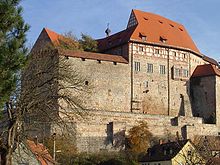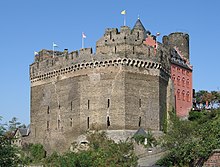Mantle wall
A mantle wall (also called high mantle ) is a ring wall of particular height that surrounds the core castle like a protective mantle. Mantle walls have been built since the 13th century and could emerge from the elevation of existing curtain walls. Compared to the shield wall, they are often less thick, but in some cases they have the same defensive function. The residential and farm buildings are usually built directly onto the mantle wall.
Concept and delimitation

The term mantle wall has only been used in castle studies for a few decades for a particularly high curtain wall that protects a castle complex in whole or in part. "High coat" previously usually referred to a noticeably high, shield-wall-like section of a curtain wall. Typical examples of this definition are Schönburg via Oberwesel on the Rhine and the Ortenburg in Alsace. At the Ortenburg, the “high coat” runs like a ship's bow around the attack side of the castle and is towered over by the keep, which usually lacks the “real” walled castles.
A very similar concept can be seen in the Palatinate Castle of Gräfenstein . Here, too, a mantle wall surrounds the keep. The Hessian castle Lindenfels formerly had both a mantle wall and a keep, which today is only preserved as a bricked-up foundation.
Often mantle walls and "high mantles" emerged from the subsequent elevation of older circular walls, so their function cannot be derived from the floor plans of the castle complexes. The construction and the defense details of such fastening concepts mostly correspond to regular circular walls.
The demarcation from a normal curtain wall of particular height and the shield wall is difficult. “Mantle wall” is one of many indistinct and not always uniformly used terms in castle history. In medieval sources, “coat” often also means lower wall sections or shield walls.
The currently common synonymous use of the terms "mantle wall" and "high mantle" is therefore problematic. In his castle studies in the early 20th century, Otto Piper still made a distinction between a mantle wall that encloses the entire castle and the "high mantle" that is only in front of part of a castle or a group of buildings.
Mantle wall castles

An impressive example of a fully developed mantle wall castle is Eisenberg Castle near Füssen in the Allgäu. The "High coat" was here protection and status symbol enough to a dungeon to do without.
The Cadolzburg Castle near Nuremberg , which was badly destroyed in the Second World War but has since been rebuilt, is essentially a high medieval mantle wall castle . As the castle of the powerful burgraves of Nuremberg from the house of Hohenzollern , the fortress is still a vivid example of this type of building despite extensive late medieval and early modern extensions. The curtain wall is three meters thick and covered with carefully crafted humpback blocks. It is only overlooked by the renewed gable roofs of the castle buildings and a slender gate tower. Accordingly, a donjon is missing here, too, which is interpreted today by some castle researchers as the classic symbol of power and status of a medieval aristocratic castle. Especially with this castle complex, however, the difficulty of delimiting a mantle wall from a high curtain wall becomes clear.
In the Upper Bavarian Anlautertal , a side valley of the better known Altmühltal , three smaller mantle wall castles are only a few kilometers apart. All castles lack a keep. At Brunneck Castle, the curtain wall behind the neck ditch is reinforced like a shield wall. The conception as a mantle wall castle becomes clearer at the nearby ruins of the Rumburg and Rundeck Castle (Stossenburg).
Illustrative examples of mantle wall castles are also the Dilsberg mountain fortress above the Neckar valley and the Leuchtenburg in South Tyrol .
literature
- German Castle Association (Hrsg.): Castles in Central Europe. A manual. Volume 1: Designs and Development. Theiss, Stuttgart 1999, ISBN 3-8062-1355-0 , pp. 230-231.
- Reinhard Friedrich: mantle wall. In: Horst Wolfgang Böhme , Reinhard Friedrich, Barbara Schock-Werner (Hrsg.): Dictionary of castles, palaces and fortresses. Philipp Reclam, Stuttgart 2004, ISBN 3-15-010547-1 , pp. 182-183, doi: 10.11588 / arthistoricum.535 .
- Otto Piper : Castle studies. Construction and history of castles . 3. Edition. Piper, Munich 1912 (Reprint Augsburg 1994), ISBN 3-89350-554-7 , p. 675.
- Joachim Zeune : Castles - symbols of power. A new image of the medieval castle . Regensburg 1997, ISBN 3-7917-1501-1 .

